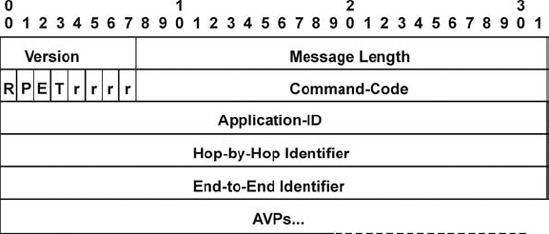19.6. Message structure
Diameter messages consist of a Diameter header, followed by a certain number of Diameter Attribute Value Pairs (AVPs). The Diameter header comprises binary data and as such is similar to an Internet Protocol (IP) header [RFC0791] or a TCP header [RFC0793]. The format of the Diameter header is shown in Figure 19.1.
Figure 19.1. Diameter header.

The command flags specify the type of Diameter message. A request message has the "R" bit (or the request bit) set, while an answer message has it cleared. The "P" bit (or the proxiable bit) indicates whether the message can be proxied or must instead be processed locally. The "E" bit (or the error bit) indicates that the answer message is an error message. The "T" bit indicates that the message is possibly a re-transmission and is set by Diameter agents in fail-over situations to aid detection of duplicate messages. The "r" bits are unused flags that are reserved for future use. Together with the Command-Code, the command flags specify the semantics associated with the particular Diameter message.
The Command-Code field indicates the command associated with the Diameter message. The Command-Code field is 24 bits long and includes values from 0 to 255 that are reserved for RADIUS backward compatibility, as well as values 16777214 and 16777215 that are reserved for experimental use. The Command-Code namespace is maintained ...
Get The IMS: IP Multimedia Concepts And Services, Second Edition now with the O’Reilly learning platform.
O’Reilly members experience books, live events, courses curated by job role, and more from O’Reilly and nearly 200 top publishers.

